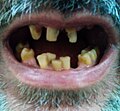Human tooth
Human tooth refers to one of the hard, calcified structures found in the mouth of many vertebrates. In humans, teeth serve primarily for masticating food, but also have secondary roles in speech and facial appearance.
Anatomy[edit]
The human tooth consists of three main parts: the crown, the neck, and the root. The crown is the visible part of the tooth, while the neck and root are embedded in the gum and jawbone respectively.
Crown[edit]
The crown of the tooth is covered by enamel, the hardest substance in the human body. Beneath the enamel is the dentine, which forms the bulk of the tooth structure.
Neck[edit]
The neck of the tooth is the part that connects the crown to the root. It is covered by the gum and is not usually visible.
Root[edit]
The root of the tooth is embedded in the jawbone and is not visible. It is covered by cementum, a hard tissue that helps to anchor the tooth in the bone.
Types of teeth[edit]
Humans have four types of teeth: incisors, canines, premolars, and molars. Each type has a specific function in the process of mastication.
Incisors[edit]
Incisors are the front teeth. They are used for cutting and chopping food.
Canines[edit]
Canines are the pointed teeth located next to the incisors. They are used for tearing food.
Premolars[edit]
Premolars are located next to the canines. They are used for crushing and grinding food.
Molars[edit]
Molars are the largest teeth. They are located at the back of the mouth and are used for grinding food.
Dental health[edit]
Maintaining good dental health is important for overall health. Regular brushing and flossing, along with regular dental check-ups, can help prevent tooth decay and gum disease.
See also[edit]
Ad. Transform your life with W8MD's Budget GLP-1 injections from $75


W8MD offers a medical weight loss program to lose weight in Philadelphia. Our physician-supervised medical weight loss provides:
- Weight loss injections in NYC (generic and brand names):
- Zepbound / Mounjaro, Wegovy / Ozempic, Saxenda
- Most insurances accepted or discounted self-pay rates. We will obtain insurance prior authorizations if needed.
- Generic GLP1 weight loss injections from $75 for the starting dose.
- Also offer prescription weight loss medications including Phentermine, Qsymia, Diethylpropion, Contrave etc.
NYC weight loss doctor appointmentsNYC weight loss doctor appointments
Start your NYC weight loss journey today at our NYC medical weight loss and Philadelphia medical weight loss clinics.
- Call 718-946-5500 to lose weight in NYC or for medical weight loss in Philadelphia 215-676-2334.
- Tags:NYC medical weight loss, Philadelphia lose weight Zepbound NYC, Budget GLP1 weight loss injections, Wegovy Philadelphia, Wegovy NYC, Philadelphia medical weight loss, Brookly weight loss and Wegovy NYC
|
WikiMD's Wellness Encyclopedia |
| Let Food Be Thy Medicine Medicine Thy Food - Hippocrates |
Medical Disclaimer: WikiMD is not a substitute for professional medical advice. The information on WikiMD is provided as an information resource only, may be incorrect, outdated or misleading, and is not to be used or relied on for any diagnostic or treatment purposes. Please consult your health care provider before making any healthcare decisions or for guidance about a specific medical condition. WikiMD expressly disclaims responsibility, and shall have no liability, for any damages, loss, injury, or liability whatsoever suffered as a result of your reliance on the information contained in this site. By visiting this site you agree to the foregoing terms and conditions, which may from time to time be changed or supplemented by WikiMD. If you do not agree to the foregoing terms and conditions, you should not enter or use this site. See full disclaimer.
Credits:Most images are courtesy of Wikimedia commons, and templates, categories Wikipedia, licensed under CC BY SA or similar.
Translate this page: - East Asian
中文,
日本,
한국어,
South Asian
हिन्दी,
தமிழ்,
తెలుగు,
Urdu,
ಕನ್ನಡ,
Southeast Asian
Indonesian,
Vietnamese,
Thai,
မြန်မာဘာသာ,
বাংলা
European
español,
Deutsch,
français,
Greek,
português do Brasil,
polski,
română,
русский,
Nederlands,
norsk,
svenska,
suomi,
Italian
Middle Eastern & African
عربى,
Turkish,
Persian,
Hebrew,
Afrikaans,
isiZulu,
Kiswahili,
Other
Bulgarian,
Hungarian,
Czech,
Swedish,
മലയാളം,
मराठी,
ਪੰਜਾਬੀ,
ગુજરાતી,
Portuguese,
Ukrainian












